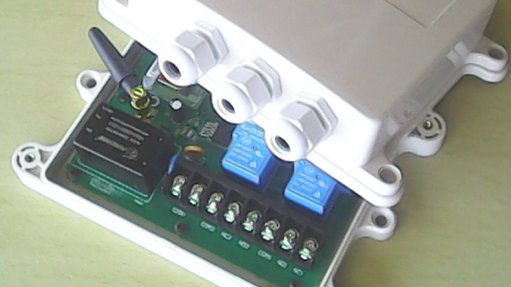
SAGITECH GSM TIME SWITCH The SAGITECH time switch is accompanied by a cellphone application, which can be programmed to automatically and remotely activate the system
Mining and other industry-focused companies can now use smartphones to switch an electricity load on or off by calling or sending SMSes to the SAGITECH GSM switch, a new remote-controlled time switch for automation and load management that was launched by Midrand-based technology innovations company Sagifon Technologies last month.
The company points out that the SAGITECH alternating or direct current time switch is accompanied by a cellphone application, which can be programmed to automatically and remotely activate the system according to the user’s needs.
Sagifon chief technology officer Billy Ruyobeza tells Mining Weekly that the new device complements Sagifon’s SAG-TO radio frequency (RF) transmitter switch and the SAG-CO RF receiver switch, which were both launched in August.
He explains that any load with an ampere rating below 30 A alternating current can be managed using the SAG-TO and SAG-CO products or the new SAGITECH GSM switches.
Ruyobeza says both systems can be used to replace all existing time switches to increase safety in the mining industry.
“If any electric circuit catches fire or an emergency situation requires an immediate shutdown, one can switch off the circuit from up to 30 m away or simply send an SMS or make a call to the switch to limit damage and possibly save lives.
“We believe that the new time switch systems will enable industrial, commercial and domestic consumers to take full control of their electricity consumption patterns and resultant costs,” asserts Ruyobeza.
System Benefits
Ruyobeza states that Sagifon’s offering is unique, as it enables consumers to switch various loads on or off at the push of a button, or by programming the switch on any smartphone using a basic application to switch a load on or off at “freely programmable times”.
He explains that existing digital time switches are limited in two ways. Firstly, as traditional digital time switch programming keypads are combined with electrical switches, consumers are exposed to the risk of electrocution and,
secondly, users have to “fiddle” with the electrical distribution box to change or update existing programming settings of the digital timer.
Ruyobeza says, for nontechnical consumers, traditional time switches are difficult to manage over the long term.
“Further, electricity is becoming extremely expensive in South Africa, and managing consumption through reliable automation is a viable solution.”
He notes, however, that the patterns of electricity consumption quite often change. Therefore, having to walk to an electrical distribution box, open it and make changes on the traditional digital timer’s settings every time patterns of consumption change is “demanding, prohibitive and a limitation on the use of digital timers to control consumption”.
Ruyobeza highlights that the SAG-TO RF transmitter enables the user to simply make changes from anywhere within 30 m of the RF receiver switch.
He says that this is also true of the SMS Scheduler application used on any android-based smartphone to time-switch various loads from anywhere in the world.
“Sagifon’s time switch systems are user friendly, reliable, easy to read and programmable. Even a lay or nontechnical person can use the devices without any fear of electrocution,” he enthuses, adding that each SAG-TO RF transmitter can be paired with up to 16 SAG-CO RF receiver switches.
“These solutions will enable consumers to control various loads with a current rating below 30 A, including, but not limited to, geysers, thermostats, lights, pools, fountains, pressure switches and humidity sensors.”
Ruyobeza further points out that the SAG-CO RF receiver switch includes a delay function, which can delay the system’s activation by between 45 minutes and three hours.
“This function enables users to switch on the load, after which the predetermined delay will automatically switch the load off, thereby ensuring effective electricity management,” he concludes.